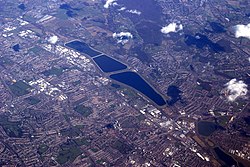Lee Valley Reservoir Chain: Difference between revisions
Created page with "{{county|Essex}} 250px|thumb|Aerial view of several of the Lee Valley reservoirs The '''Lee Valley Reservoir Chain''' is located in the Le..." |
No edit summary |
||
| Line 6: | Line 6: | ||
==Geographic significance== | ==Geographic significance== | ||
The Chain separates | The Chain separates Middlesex to the west, from Essex to the east. The corridor includes 13 reservoirs, two to three channels of the [[River Lea|Lee]], as well as marshes and parkland, up to a mile wide. | ||
During WWI, the settlements on both sides of the Upper Lea were badly hit by | During WWI, the settlements on both sides of the Upper Lea were badly hit by German Army and Navy airship raids. It is believed the crews mistook the Reservoir Chain for the Thames and released their bombs on what they took to be central London.<ref>London 1914-17 The Zeppelin Menace, Ian Castle. Osprey Publishing 2008</ref> | ||
The corridor is part of the [[Metropolitan Green Belt]] and its national and international significance for wildlife is reflected by SSSI, Ramsar and SPA designations.<ref>Walthamstow Wetlands SSSI details includes reference to other designations https://designatedsites.naturalengland.org.uk/SiteGeneralDetail.aspx?SiteCode=UK9012111&SiteName=&countyCode=&responsiblePerson=&unitId=&SeaArea=&IFCAArea=</ref> Lying between some of the most densely populated areas in the metropolis, the Reservoir Chain and associated open land provides a highly valued ecological, landscape and recreational resource for the local population. | The corridor is part of the [[Metropolitan Green Belt]] and its national and international significance for wildlife is reflected by SSSI, Ramsar and SPA designations.<ref>Walthamstow Wetlands SSSI details includes reference to other designations https://designatedsites.naturalengland.org.uk/SiteGeneralDetail.aspx?SiteCode=UK9012111&SiteName=&countyCode=&responsiblePerson=&unitId=&SeaArea=&IFCAArea=</ref> Lying between some of the most densely populated areas in the metropolis, the Reservoir Chain and associated open land provides a highly valued ecological, landscape and recreational resource for the local population. | ||
Latest revision as of 16:55, 16 October 2020

The Lee Valley Reservoir Chain is located in the Lee Valley, forming part of the border between Middlesex and Essex. It comprises 13 reservoirs that supply drinking water to London.[1]
The Reservoir Chain is a major geographic constraint; together with the Thames it is one of the two significant topographic features that divide the capital and define the communities on either side. The Lower Lea Valley, downstream of the reservoirs, is more integrated, with better east-west transport connectivity.
Geographic significance
The Chain separates Middlesex to the west, from Essex to the east. The corridor includes 13 reservoirs, two to three channels of the Lee, as well as marshes and parkland, up to a mile wide.
During WWI, the settlements on both sides of the Upper Lea were badly hit by German Army and Navy airship raids. It is believed the crews mistook the Reservoir Chain for the Thames and released their bombs on what they took to be central London.[2]
The corridor is part of the Metropolitan Green Belt and its national and international significance for wildlife is reflected by SSSI, Ramsar and SPA designations.[3] Lying between some of the most densely populated areas in the metropolis, the Reservoir Chain and associated open land provides a highly valued ecological, landscape and recreational resource for the local population.
Reservoirs
The following waters are known collectively as the Chingford Reservoirs, which are a Site of Special Scientific Interest:[4]
The following waters, together known as the Walthamstow Reservoirs, and with the exception of one, form a Site of Special Scientific Interest:[4][5]
- Lockwood Reservoir
- High Maynard Reservoir
- Low Maynard Reservoir
- East Warwick Reservoir
- West Warwick Reservoir
- Unnamed reservoirs numbered 1 to 5
- Banbury Reservoir (The only reservoir that is not part of a SSSI)
The reservoirs have the following characteristics:[6]
| Reservoir | Water Source (see below) | Water Supply | Depth | Capacity |
|---|---|---|---|---|
| King George V | River Lea, New River, Lea Diversion | Pumped | 24 ft 8 in | 2,750,000 gallons |
| William Girling | Lea Diversion | Pumped | 41 ft | 3,600,000 gallons |
| Banbury | Lea Diversion & Thames-Lee tunnel | Pumped | 27 ft 11 in | 650,000 gallons |
| Lockwood | Lea Diversion & Thames-Lee tunnel | Pumped | 34 ft 2 in | 550,000 gallons |
| High Maynard | Lee Diversion, Walthamstow No. 4, East Warwick | Gravity-fed | 19 ft | 150,000 gallons |
| Low Maynard | High Maynard | Gravity-fed | 9 ft 10 in | 33,000 gallons |
| East Warwick | High Maynard, West Warwick | Gravity-fed | 19 ft | 210,000 gallons |
| West Warwick | East Warwick | Gravity-fed | 19 ft | 176,000 gallons |
| Walthamstow No. 4 | High Maynard, Walthamstow No. 5 | Gravity-fed | 19 ft | 130,000 gallons |
| Walthamstow No. 5 | Walthamstow No. 4 | Gravity-fed | 19 ft | 170,000 gallons |
Water supply
The reservoirs are fed by the following waters:
- River Lee Diversion
- River Lee Flood Relief Channel
- New River
- The Thames-Lee Water Main
Water treatment
After being stored in the above reservoirs the water is piped to the Coppermills Water Treatment Works.[7]
References
- ↑ Reservoir information Retrieved November 9, 2007
- ↑ London 1914-17 The Zeppelin Menace, Ian Castle. Osprey Publishing 2008
- ↑ Walthamstow Wetlands SSSI details includes reference to other designations https://designatedsites.naturalengland.org.uk/SiteGeneralDetail.aspx?SiteCode=UK9012111&SiteName=&countyCode=&responsiblePerson=&unitId=&SeaArea=&IFCAArea=
- ↑ 4.0 4.1 "Lee Valley Regional Park Authority, Reservoirs". http://www.leevalleypark.org.uk/en/content/cms/leisure/water_sports___activ/reservoirs/reservoirs.aspx. Retrieved 2011-09-05.
- ↑ Natural England, Nature on the Map (Search on Walthamstow Reservoirs)
- ↑ https://web.archive.org/web/20110124142453/http://paginas.fe.up.pt/~mjneves/publicacoes_files/data/es/ponencias/por_autor/pdf/10109.pdf
- ↑ Coppermills Retrieved November 9, 2007